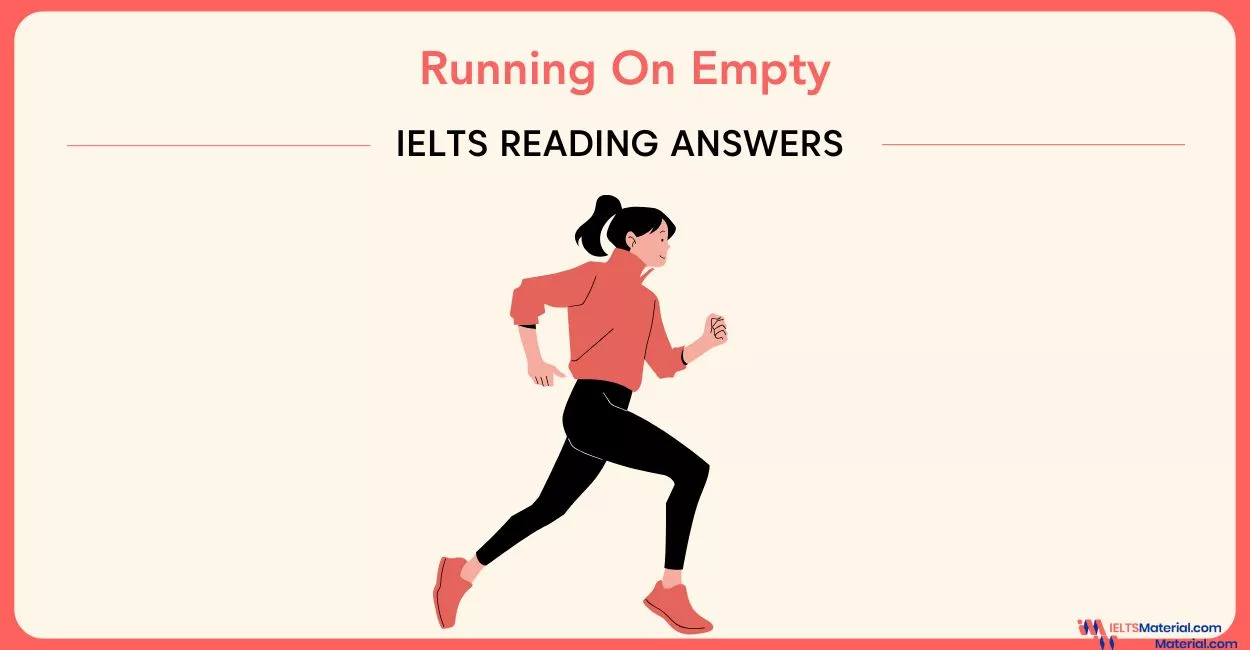Running On Empty IELTS Reading Answers
3 min read
Updated On
-
Copy link
Want to enhance your Reading skills? Try the Running On Empty IELTS Reading Practice Test and check your answers along with their explanations here! Also, explore our smart expert-written techniques to solve even the trickiest question types!
Table of Contents

Limited-Time Offer : Access a FREE 10-Day IELTS Study Plan!
This article contains the Running On Empty IELTS reading answers. The Running On Empty is a real Reading test passage that appeared in the IELTS.
With diligent practice, the Reading Module can be the top-scoring category for IELTS Aspirants. To score well, you must understand how to approach and answer the different question types in the IELTS Reading Module.
By solving and reviewing Sample Reading Questions from past IELTS papers, you can ensure that your Reading skills are up to the mark. Take the practice test Running On Empty below and try more IELTS reading practice tests from IELTSMaterial.com.
Not sure how to answer IELTS Reading Matching Headings questions? Check out the video below for the latest tips and strategies!
For more Matching Headings Questions practice, take a look at IELTS Reading Tips & Practice Test: Matching Headings to Paragraphs exercises!
Running On Empty Passage
You should spend about 20 minutes on Questions 1-13, which are based on the Reading Passage below. Find the practice test with the Running On Empty PDF here.
Running On Empty IELTS Reading Answers
| Question number | Answer | Keywords | Location of keywords |
|---|---|---|---|
| 1 | iii | For almost a century, scientists have presumed, not unreasonably, that fatigue – or exhaustion in athletes originates in the muscles. | Paragraph A;
Line 1 |
| 2 | vi | The essence of their new theory is that the brain, using a mix of physiological, subconscious and conscious cues, paces the muscles to keep them well back from the brink of exhaustion. | Paragraph B;
Line 4 |
| 3 | ii | But when research subjects exercise in conditions simulating high altitude, they become fatigued even though lactic acid levels remain low. | Paragraph C;
Line 3 |
| 4 | vii | Probing further, Noakes conducted an experiment with seven cyclists who had sensors taped to their legs to measure the nerve impulses travelling through their muscles. | Paragraph D;
Line 1 |
| 5 | viii | But his team found exactly the opposite. | Paragraph E;
Line 2 |
| 6 | iv | ‘The cyclists may have felt completely exhausted,’ he says, ‘but their bodies actually had considerable reserves that they could theoretically tap by using a greater proportion of the resting fibres.’ | Paragraph F;
Line 2 |
| 7 | C | Lactic acid is a by-product of exercise, and its accumulation is often cited as a cause of fatigue. | Paragraph C;
Line 2 |
| 8 | A | In other words, muscles tire because they hit a physical limit: they either run out of fuel or oxygen or they drown in toxic by-products. | Paragraph A;
Line 3 |
| 9 | B | the brain is regulating the pace of the workout to hold the cyclists well back from the point of catastrophic exhaustion | Paragraph F;
Line 3 |
| 10 | C | But the central governor theory does not mean that what’s happening in the muscles is irrelevant. The governor constantly monitors physiological signals from the muscles, along with other information, to set the level of fatigue. | Paragraph I;
Lines 1- 2 |
| 11 | B | Noakes believes that the central regulator evaluates the planned workout, and sets a pacing strategy accordingly | Paragraph J;
Line 2 |
| 12 | A | if fatigue is caused by muscles poisoning themselves with lactic acid | Paragraph H;
Line 2 |
| 13 | B | St Clair Gibson believes there is a good reason why our bodies are designed to keep something back. That way, there’s always something left in the tank for an emergency. | Paragraph K;
Lines 1 – 2 |
Book a FREE online class to know more about the IELTS questions in ‘Running On Empty Reading’!
Improve Your Reading Skills for IELTS with IELTSMaterial
We really think that practising more IELTS reading actual tests and IELTS Academic Reading practice tests, like T-Rex Hunter Reading Answers with the detailed explanation, would be super helpful to you!
If you’re wondering how to ace the IELTS reading exam by improving your weak spots, come join our free demo classes and have a chat with an IELTS expert. Don’t forget to join the interactive webinars where you’ll learn secret tricks to ace the IELTS reading test. Drop a comment below and tell us how it’s benefited your preparation!
Check More IELTS Reading Answers
Also check :
Practice IELTS Reading based on question types

Start Preparing for IELTS: Get Your 10-Day Study Plan Today!
Recent Articles

Nehasri Ravishenbagam

Haniya Yashfeen

Haniya Yashfeen

Haniya Yashfeen




Post your Comments